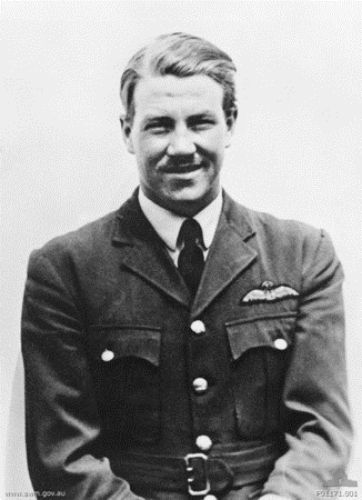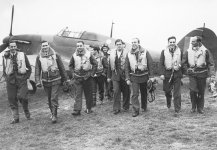Group Captain Sir Douglas Robert Steuart Bader /ˈbɑːdər/ CBE DSO DFC FRAeS DL
Here is a passage on this legendary fighter pilot from wiki;
On 11 July, Bader scored his first kill with his new squadron.[50] The cloud base was down to just 600 ft while drizzle and mist covered most of the sky, and forward visibility was down to just 2,000 yards. Bader was alone on patrol, and was soon directed toward an enemy aircraft flying north up the Norfolk coast.[51] Spotting the aircraft at 600 yards, Bader recognised it as a Dornier Do 17, and after he closed to 250 yards its rear gunner opened fire. Bader continued his attack and fired two bursts into the bomber before it vanished into cloud.[52] The Dornier, which crashed into the sea off Cromer, was later confirmed by a member of the Royal Observer Corps. On 21 August, a similar engagement took place. This time, a Dornier went into the sea off Great Yarmouth and again the Observer Corps confirmed the kill. There were no survivors.[53][54]
Later in the month, Bader scored a further two victories over Messerschmitt Bf 110s.[55][56] On 30 August 1940, No. 242 Squadron was moved to Duxford again and found itself in the thick of the fighting.[49] On this date, the squadron claimed 10 enemy aircraft, Bader scoring two kills against Bf 110s.[57] Other squadrons were involved, and it was impossible to verify which RAF units were responsible for the damage on the enemy.[58] On 7 September, two more Bf 110s were shot down, but in the same engagement Bader was badly hit by a Messerschmitt Bf 109. Bader nearly decided to bail out, but recovered the Hurricane. Other pilots witnessed one of Bader's victims crash.[59]
On 7 September, Bader claimed two Bf 109s shot down, followed by a Junkers Ju 88.[60] On 9 September, Bader claimed another Dornier.[61] During the same mission, he attacked a He 111 only to discover he was out of ammunition. Enraged, he thought about ramming it and succeeded in slicing off the rudder with his propeller, but broke off the attack when he regained his composure. The He 111 continued onward, badly damaged.[62] On 14 September, Bader was awarded the Distinguished Service Order (DSO) for his combat leadership.[63]
On 15 September, known as the Battle of Britain Day, Bader damaged a Do 17 and a Ju 88, while destroying another Do 17 in the afternoon.[64] Bader flew several missions that day, which involved heavy air combat.[65] The original combat report states that he destroyed one enemy aircraft, claimed no probable, but did claim several damaged.[66] The Dornier's gunner attempted to bail out, but his parachute was caught on the tail wheel and he died when the aircraft crashed into the Thames Estuary.[67] Further detail suggests Bader took pity on the gunner and "tried to kill him to put him out of his misery".[68] Another Do 17 and a Ju 88 were claimed on 18 September.[60] A Bf 109 was claimed on 27 September.[69] Bader was gazetted on 1 October 1940.[70] On 24 September, he had been promoted to the war substantive rank of flight lieutenant.[71]
As a friend and supporter of his 12 Group commander, Air Vice-Marshal Trafford Leigh-Mallory, Bader joined him as an active exponent of the controversial "Big Wing" theory which provoked much debate in the RAF during the battle.[72] Bader was an outspoken critic of the careful "husbanding" tactics being used by Air Vice-Marshal Keith Park, the commander of 11 Group. Park was supported by Fighter Command Air Chief Marshal Sir Hugh Dowding, the overall commander. Bader vociferously campaigned for an aggressive policy of assembling large formations of defensive fighters north of London ready to inflict maximum damage on the massed German bomber formations as they flew over South East England. As the Battle progressed, Bader often found himself at the head of a composite wing of fighters consisting of up to five squadrons. Achievements of the Big Wing were hard to quantify, as the large formations often took too long to form up, over claimed kills, and too often did not provide timely support of the over-committed 11 Group. The episode probably contributed to the departure of Park, who was replaced with Leigh-Mallory in November 1940, and Dowding.[73] While it is not known whether Mallory and Bader were aware that the claims of the RAF and Big Wings were exaggerated, they certainly tried to use them as a potent tool with which to remove Park and Dowding from command and pursue the Big Wing tactic.[74] After the war, Bader insisted that both he and Leigh-Mallory wanted the Big Wing tactic enacted in 12 Group only. They both believed, according to Bader, that it was impractical to use it in 11 Group, as the command was located too close to the enemy and would not have enough time to assemble.[75]
RAF ace Johnnie Johnson offered a balanced view of Bader and the Big Wing:
"Douglas was all for the Big Wings to counter the German formation
. I think there were room for both tactics – the Big Wings and the small squadrons. It might well have been fatal had Park always tried to get his squadrons into "Balbos", for not only would they have taken longer to get to their height, but sixty or seventy packed climbing fighters could have been seen for miles and would have been sitting ducks for higher 109s. Also nothing would have pleased Göring more than for his 109s to pounce on large numbers of RAF fighters. Indeed, Adolf Galland and Werner Mölders complained about the elusiveness of Fighter Command and Park's brilliance was that by refusing to concentrate his force he preserved it throughout the battle. This does not mean, as Bader pointed out at the time, that two or three Balbos from 10 and 12 Groups, gaining height beyond the range of the 109s, would not have played a terrific part in the fighting."[76]
















